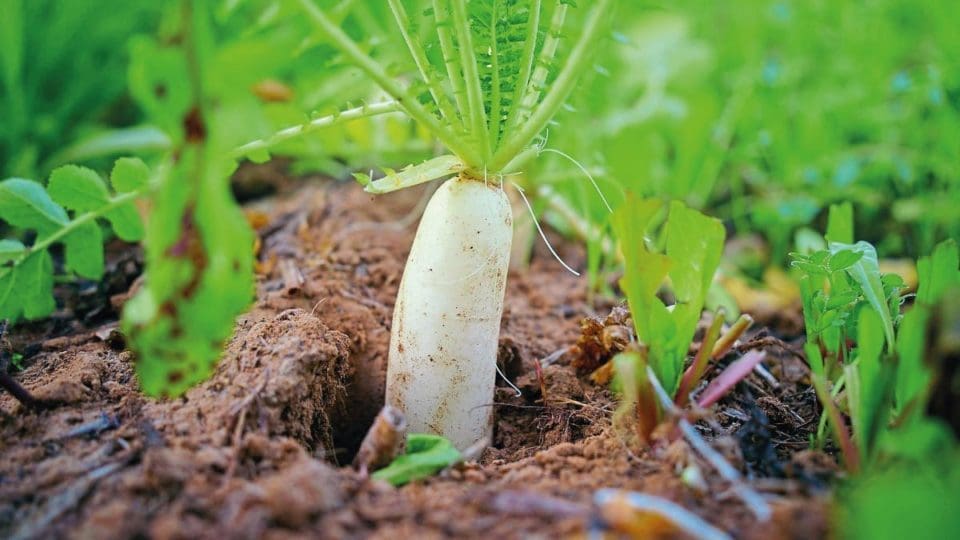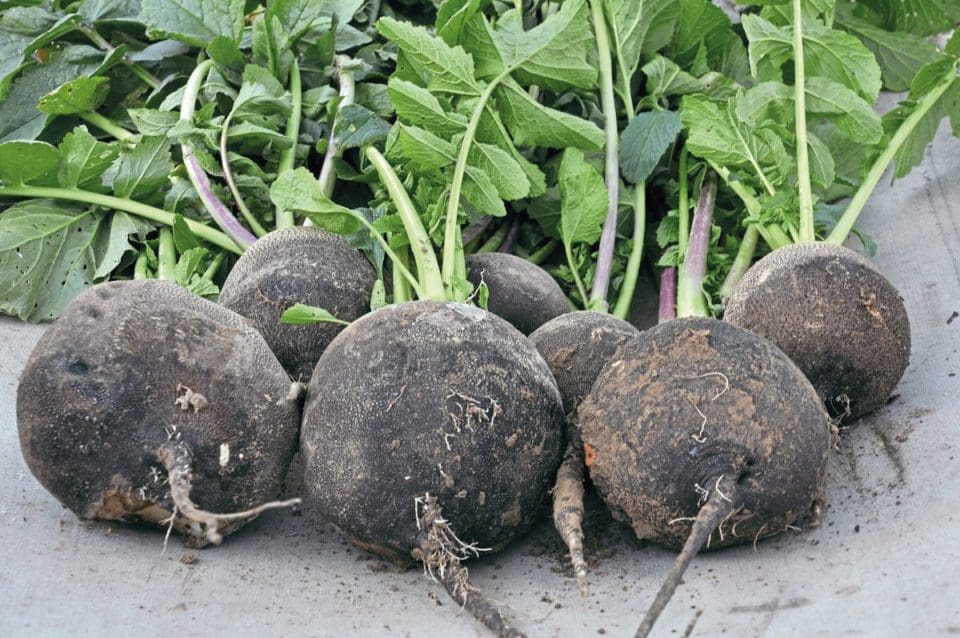Winter radish is a crop that can be sown now and will mature really quickly. Emma Rawlings offers some advice on which ones to grow and how.
The little red rooted radishes that give a hot flavour to our salads are well known, but there are also some pungent winter radishes which are a great crop for later in the season and into the winter. They can be sown now for producing roots that are perfect for your winter stews, soups or roasting.
What are winter radish?
There are three main ones to look out for and these are the ‘Black Spanish Round’, the mooli and the watermelon radish. They are very different in looks – but all worth a try.
Watermelon radish
This is a daikon type but round with the same white skin, but the inside colour is stunning. The outer edge is a vivid green and the internal flesh a beautiful pink. It does look very watermelon-like. It also has the name red meat for obvious reasons. It has a mild flavour and cooking this one enhances the sweetness of it. There is a variety called ‘Red Flesh’ from The Real Seeds Catalogue (www.realseeds.co.uk). The company also sells a variety called ‘Green Luobo’ which is out of stock currently but more seeds are due at the end of November. This heirloom variety from China has bright green flesh and green/white skin.

Mooli
This also comes under the name of daikon (meaning ‘big root’) which is a name given to winter radishes from Asia and it produces very long carrot-like roots. This radish has crisp flesh that is mild flavoured and can be used in stir-fries or in salads. The roots can be harvested as soon as they are large enough, so about 10cm (4in) long or wait for them to get a bit bigger. Some varieties will produce very long roots such as ‘April Cross’. The roots can grow up to 30cm (12in) long. It has a mild flavour and is ideal sliced thinly and added to stir-fries. There is also a pink-red rooted variety available called ‘Dragon F1’.

Radish ‘Black Spanish Round’
This black radish is an heirloom variety that has been around since the 16th century. It grows to about tennis ball size and has black skin and pure white flesh inside. It has quite a hot flavour but is tempered by cooking and so can be added to stews or soups or used in stir-fries. It can be used in salads too.

How to grow winter radishes
Radish likes a well-drained fertile soil so add plenty of organic matter such as material from your compost bin. They also prefer a sunny spot on the plot and a moist soil, which is usually not a problem come autumn.
You can sow winter radish June to September direct on the plot in shallow drills about 1.5cm (½in) deep. Space rows about 30cm (12in) apart. The weather may be quite dry when you sow these so keep the ground watered and especially when the plants are still small.
When they emerge, thin out the seedlings to leave gaps between the plants. It can be done gradually as they continue to grow until the plants are about 10cm (4in) apart.
Keep the seedlings watered if there is a dry spell and watch out for flea beetles, which attack the leaves and make small holes in them. Covering with fleece or fine insect mesh can help before the seedlings are even through.

How and when to harvest winter radishes
Like the red summer radishes, these winter ones do grow quickly and can be ready in about six to 10 weeks. They can sit in the ground for a while if you are not ready to eat them and if you cover the crop with straw, it may prevent damage by frosts – but before the very depths of winter arrive it may be best to lift the crop and store in boxes of sand in a cool place.
In the kitchen
Winter radishes can be used like their smaller red salad radishes in salads but they are so much more versatile. A quick Google search will produce lots of delicious recipes for winter radish – such as shredding the radish in a coleslaw, searing slices in a pan, adding to stir-fries or cutting them into cubes and adding to soups and stews. There are many ways to use winter radishes.





